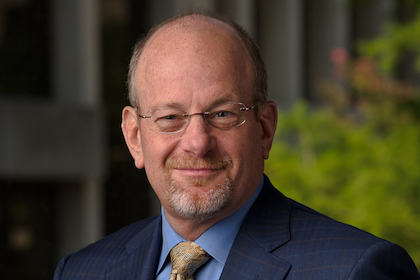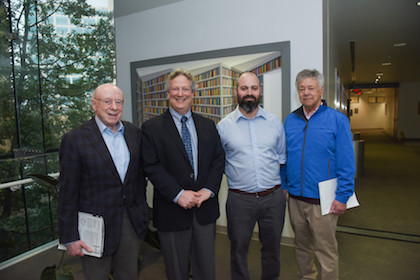2015 Women’s Health Symposium combines humor, serious subject matter
By Lin Lofley
The 2015 Carolyn P. Horchow Women’s Health Symposium included some playful banter among the heart doctors and the brain doctors, but most of the discussion for more than 100 invited guests was a serious examination of what people need to do in the case of life-threatening conditions such as stroke, and about lifestyle-threatening conditions such as the onset of cataracts.
Titled “First Steps & Second Chances: From disease prevention to life-renewing treatments,” the symposium is an annual event at UT Southwestern Medical Center focused on presenting health care topics in an informal setting, and to commemorate the life of Mrs. Horchow, a longtime Dallas resident and philanthropist who co-founded the symposium in 1999 with her friend, Patricia M. Patterson.
The roster of featured researchers and clinicians included Dr. Eric Olson, Chairman of Molecular Biology; Dr. Amit Khera, Associate Professor of Internal Medicine; Dr. Sandhya Iyer, Assistant Professor of Ophthalmology; Dr. Mark Goldberg, Chairman of Neurology and Neurotherapeutics; and Dr. Kathleen Bell, Chairman of Physical Medicine and Rehabilitation.
Co-chairs for the 2015 symposium, Marissa Anchia, Margo Ramirez Keyes – who provided welcoming remarks – and Leticia “Letty” Ramirez, are sisters who have longstanding commitments to Dallas health care initiatives, and especially to the underserved.
Dr. Carol Croft, Professor of Internal Medicine, introduced the speakers and served at the event with Dr. Carol Podolsky, Physician Advisor to the Women’s Health Symposium. Dr. Podolsky is a renowned pediatrician who serves the area through a variety of health care initiatives.
Dr. Olson kicked off the program, speaking of his fascination with “one of nature’s most wondrous creations, the heart.” His research focuses, as he said, “on the repair of injured hearts and hearts that are failing.
“A person can function without a brain – teenagers do it all the time,” Dr. Olson said with a smile, “but there is no life without the heart.” That tongue-in-cheek statement set the stage for friendly rejoinders from two of the clinicians who presented later.
Dr. Olson’s research team is trying to see how injured hearts, post-heart attack, can regain the use of muscle cells.
Dr. Khera, Director of the Preventive Cardiology Program, is among many on campus who are studying heart disease. He began his talk by mentioning how difficult it is to follow Dr. Olson to the lectern, and said he’d try to, in 25 minutes, “tell you all you need to do so you never have to worry about regenerating your heart.”
In a discussion of heart disease risk factors – such as high blood pressure, low “good” cholesterol, and diabetes – Dr. Khera said that where heart disease is concerned “not one thing matters, but everything matters.”
Dr. Iyer, in a discussion of the medicine of the eye, drew the greatest reaction from the audience when she explained the latest innovations in cataract surgery.
The femtosecond laser, Dr. Iyer said, adds computer-control to key steps of the cataract surgery procedure. It helps the surgeon design a customized procedure, “waffle-cut” the cataract, and prepare it for removal. She responded to the audience’s amazement by saying “the longest procedure has been 47 seconds.”
Dr. Goldberg, Professor of Neurology and Neurotherapeutics, began his talk with a discussion of the transition of the Zale Lipshy University Hospital, which will become “the home to brain diseases on our campus.”
But, smiling at Dr. Olson, Dr. Goldberg sought to explain that “the brain is the important organ.” Turning to the audience, he invited the group to “think about how important the brain is, which you can do because you have a brain.”
Dr. Goldberg said clinicians used the model of trauma centers to determine how to change the way stroke patients are treated. “If you’re in a serious car accident, you’re taken by helicopter,” he said. “Not to the nearest hospital, but to the nearest trauma center; that’s where you want to go, because that’s where the expertise is.”
Primary Stroke Centers, of which there are now more than 1,000 in the U.S., have been created in the last decade. UT Southwestern’s facility, the Robert D. Rogers Advanced Comprehensive Stroke Center, celebrated its certification’s 1st anniversary in 2015. Comprehensive stroke centers provide a team approach to treatment, Dr. Goldberg said.
For her part, Dr. Bell immediately leapt to the defense of teenagers: “I must point out to Dr. Olson that teenagers have brains. They don’t have functioning frontal lobes, but they do have brains.”
Calling herself “the new kid in town,” Dr. Bell said the symposium was completely fascinating, in part because her own mother had congestive heart failure, advanced macular degeneration, cataracts, and a stroke. “I have lived through all of these in my family, all of these in one person.”
She spoke about what happens after a stroke, and about what happens after traumatic brain injury (TBI).
Carolyn P. Horchow, for whom the symposium is named, was co-founder of The Horchow Collection, the first luxury mail-order catalog. She was the wife of Dallas philanthropist and retail entrepreneur Roger Horchow, and served on several boards, including the Board of Visitors of UT Southwestern University Hospitals & Clinics.
###
Dr. Bell holds the Kimberly-Clark Distinguished Chair in Mobility Research.
Dr. Goldberg holds the Linda and Mitch Hart Distinguished Chair in Neurology.
Dr. Khera holds the Dallas Heart Ball Chair in Hypertension and Heart Disease.
Dr. Olson holds the Pogue Distinguished Chair in Research on Cardiac Birth Defects, The Robert A. Welch Distinguished Chair in Science, and the Annie and Willie Nelson Professorship in Stem Cell Research.



